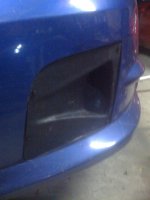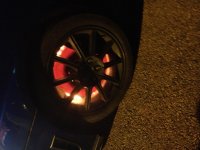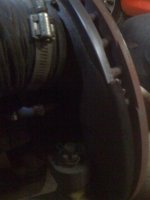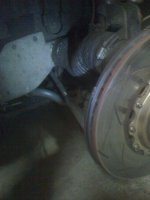Cat in Hat
New member
Over the last 5 years my car has slowly become more and more of an event car and less like a road car. The metamorphosis has included weight saving, significant suspension upgrades and some power gains. All in all the car has been very successful...I have had very few reliability issues and a lot of success in a lot of events. The one single weak point has been keeping the brakes cool.
Unfortunately my "Home" race track (Zwartkops raceway) is notoriously hard on brakes and challenges race cars in every class.
This thread is intended to be a journal of what has been done in an attempt to solve this problem. Fortunately a lot of events that I take part in do not include many consecutive laps around a track, but are more like a time attack format, gymkhana or hill climb so the brake cooling is not a problem. But from time to time consecutive hot laps are necessary and this is when the problem arises. This past weekend's rally was such an event.
The current brake setup has been in place for some years : OEM Brembo calipers, DBA series 5000 rotors, Performance friction pads (full race spec), Performance friction PF665 brake fluid, braided brake lines.
I have tried various brands of brake fluids to try prevent fade and found Endless 660 to be the best so far.
This setup on its own works well for about 3 or 4 hot laps, but brake fade inevitably ends the fun there and then.
Mod 1. Roo ducts. These were fitted without any ducting to the Roo intake and also no ducting to the wheel hub. The fog light covers were removed to allow air to pass into the ducts. Result = no improvement
Mod 2. Roo Ducts with intake ducting and ducting from the Roo to the centre of the wheel hub/rotor. This seemed to help a bit but it still did not allow me to do more than 3 or 4 laps.
Mod 3. Added bigger - home made intakes to Roo ducting. Still no improvement.
At this stage I decided to take a closer look at the aerodynamics of the intakes because there seemed to be no reason why the ducting had such an insignificant affect. I mixed up a bit of paint that would not dry quickly, placed a few dots around the intakes and went for a drive. I left the one intake as it was and on the other I fitted a small lip to the outside of the intake hoping to deflect more air into the ducting. Here are some pics of the experiment...I only wish I knew how to mix a better paint brew for the exercise:?
Paint spots before driving
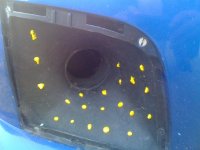
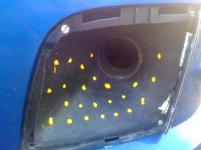
Paint spots after a drive
no lip with lip (deflector)
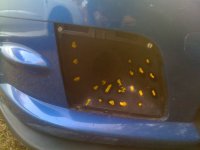
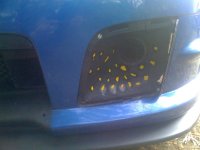
The lip that made a noticeable difference to the air flowing into the intake.

Unfortunately my "Home" race track (Zwartkops raceway) is notoriously hard on brakes and challenges race cars in every class.
This thread is intended to be a journal of what has been done in an attempt to solve this problem. Fortunately a lot of events that I take part in do not include many consecutive laps around a track, but are more like a time attack format, gymkhana or hill climb so the brake cooling is not a problem. But from time to time consecutive hot laps are necessary and this is when the problem arises. This past weekend's rally was such an event.
The current brake setup has been in place for some years : OEM Brembo calipers, DBA series 5000 rotors, Performance friction pads (full race spec), Performance friction PF665 brake fluid, braided brake lines.
I have tried various brands of brake fluids to try prevent fade and found Endless 660 to be the best so far.
This setup on its own works well for about 3 or 4 hot laps, but brake fade inevitably ends the fun there and then.
Mod 1. Roo ducts. These were fitted without any ducting to the Roo intake and also no ducting to the wheel hub. The fog light covers were removed to allow air to pass into the ducts. Result = no improvement
Mod 2. Roo Ducts with intake ducting and ducting from the Roo to the centre of the wheel hub/rotor. This seemed to help a bit but it still did not allow me to do more than 3 or 4 laps.
Mod 3. Added bigger - home made intakes to Roo ducting. Still no improvement.
At this stage I decided to take a closer look at the aerodynamics of the intakes because there seemed to be no reason why the ducting had such an insignificant affect. I mixed up a bit of paint that would not dry quickly, placed a few dots around the intakes and went for a drive. I left the one intake as it was and on the other I fitted a small lip to the outside of the intake hoping to deflect more air into the ducting. Here are some pics of the experiment...I only wish I knew how to mix a better paint brew for the exercise:?
Paint spots before driving


Paint spots after a drive
no lip with lip (deflector)


The lip that made a noticeable difference to the air flowing into the intake.


